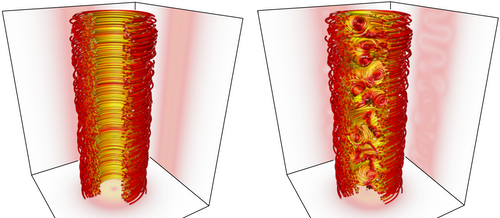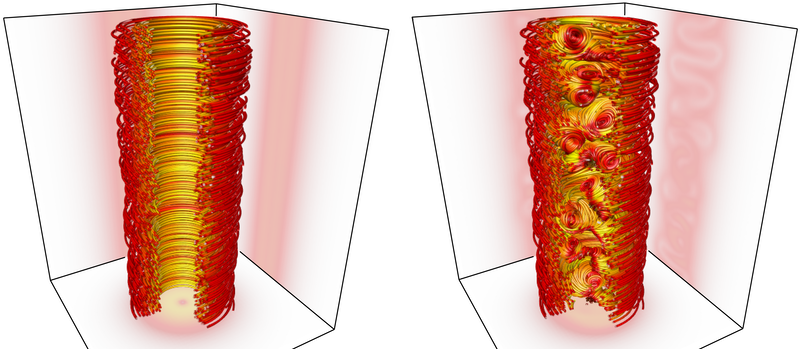Black Hole as Extreme Particle Accelerator
Astrophysicists have theorized for decades that the mysterious, ultrahigh-energy cosmic rays (UHECRs) detected on Earth could come from active galactic nuclei (AGNs), the supermassive black holes at the centers of galaxies. The particle acceleration mechanism, however, has been unclear. Now a team of researchers has used simulations of unprecedented size to propose a mechanism. The results strengthen the idea of AGNs as UHECR sources, although some experts caution that the simulations have limitations when used to predict protons of such high energies.
Most cosmic rays are protons or atomic nuclei with energies around . UHECRs have energies above and have been sporadically detected on Earth since the 1960s, though their sources have remained uncertain. A recent coincident detection of a high-energy neutrino and a gamma ray from an AGN was seen as strong evidence for AGNs as UHECR sources, since both of these events can be explained by the acceleration of protons to ultrahigh energies [1]. Still, other UHECR-source candidates, such as relativistic supernovae and gamma-ray bursts, remain viable possibilities.
Astrophysical jets are beams of ionized matter emitted in both directions along the axis of rotation of a massive astronomical object, such as an AGN. Relativistic AGN jets—where some particles move at close to the speed of light—have been thoroughly studied, both observationally and theoretically. Most of their energy is stored in powerful magnetic fields that take on a helical structure. Previous simulations have demonstrated that the jet plasma is not stable; interactions with the interstellar medium cause distortions of the jet called kink instabilities, where the jet's column-like shape bends and twists.
Researchers have suspected that these kink instabilities could produce electric fields strong enough to accelerate particles to ultrahigh energies and have even seen suggestive gamma- and x-ray emission from these structures. But theorists have not understood exactly how the acceleration process would work.
Frederico Fiuza of the SLAC National Accelerator Laboratory in Menlo Park, California, and his team decided to take their simulations of an AGN jet to an unprecedented scale: while previous simulations had modeled the jet plasma as a fluid, providing a coarse description, they would model it at the level of individual particles. The large computational power required for this project has prevented others from trying it sooner, explains SLAC team member Paulo Alves.
The team’s simulations, performed on a supercomputer, followed 550 billion particles in a “co-moving” reference frame as the particles flowed outward from a smooth region of the jet through a kink instability, where the field constantly wiggles and bends. The researchers did not attempt to follow the particles as they moved through the entire jet but focused on the activity near the instability.
The team found that the magnetic field’s continuous wiggling induces a powerful electric field that is generally along the direction of the jet, perpendicular to the smoother parts of the magnetic field, which wrap around the jet. But this electric field wouldn’t ordinarily be able to accelerate charged particles because they are usually restricted to move along magnetic field lines. However, in the simulations, the kink instability tangled the magnetic field lines enough that the particles could cross them and could be accelerated by the electric field to energies high enough to become UHECRs.
“What is distinctive and exciting about our recent work,” Fiuza says, “is that it shows that a mechanism that operates naturally in the magnetic field structure known to exist in AGN jets can simultaneously explain the generation of high-energy radiation and high-energy cosmic rays.”
“I think that this paper represents an important advance in understanding magnetic energy conversion to energetic particles in jets,” says plasma physicist James Drake of the University of Maryland, College Park. Although the simulations produce strong electric fields, Drake was not convinced that protons would be accelerated all the way up to . Extrapolating from the simulations to such high energies requires a more realistic mix of electrons, positrons, and protons, he says, whereas the simulations used mainly electrons and positrons.
Astrophysicist Marc Swisdak, also from the University of Maryland, College Park, is also impressed. “This paper gives a convincing description” of the new acceleration mechanism, he says. This mechanism could potentially operate in the Earth’s magnetosphere or the solar corona, so “this work could represent a big step forward.”
This research is published in Physical Review Letters.
–Meredith Fore
Meredith Fore is a freelance science writer and graduate student at the University of Washington, Seattle.
References
- M. G. Aartsen et al. (IceCube Collaboration), “Neutrino emission from the direction of the blazar TXS 0506+056 prior to the IceCube-170922A alert,” Science 361, 147 (2018).





